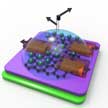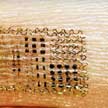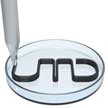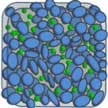Showing Spotlights 857 - 864 of 2878 in category All (newest first):
 Electrocatalysis offers important opportunities for clean fuel production, but uncovering the chemistry at the electrode surface remains a challenge. Here, this work exploits a single-nanosheet device to perform in-situ measurements of water oxidation electrocatalysis and reveal a crucial interaction with oxygen. The obtained in-depth understanding could provide valuable clues for catalysis system design and the in-situ measurement could be also useful to analyze other interfacial reaction processes.
Electrocatalysis offers important opportunities for clean fuel production, but uncovering the chemistry at the electrode surface remains a challenge. Here, this work exploits a single-nanosheet device to perform in-situ measurements of water oxidation electrocatalysis and reveal a crucial interaction with oxygen. The obtained in-depth understanding could provide valuable clues for catalysis system design and the in-situ measurement could be also useful to analyze other interfacial reaction processes.
Sep 29th, 2017
 Nanotechnology materials are going to open new realms of possibility for flexible and stretchable monitoring gadgets that are wearable directly on the skin. Here we look at the latest developments in a class of electronic devices, commonly referred to as electronic skin, epidermal electronics, or electronic tattoos, from the materials, devices, and medical applications perspectives. While such devices can also be used for prosthetics and rehabilitation, optogenetics, and human-machine interfaces, this review focuses on the properties of the materials that enable skin-mounted sensors for use as diagnostic tools in the medical field.
Nanotechnology materials are going to open new realms of possibility for flexible and stretchable monitoring gadgets that are wearable directly on the skin. Here we look at the latest developments in a class of electronic devices, commonly referred to as electronic skin, epidermal electronics, or electronic tattoos, from the materials, devices, and medical applications perspectives. While such devices can also be used for prosthetics and rehabilitation, optogenetics, and human-machine interfaces, this review focuses on the properties of the materials that enable skin-mounted sensors for use as diagnostic tools in the medical field.
Sep 26th, 2017
 Researchers have focused on nanocellulose as a novel biomaterial with industrial and scientific applications, which range from the creation of new kinds of commercially useful materials and uses in medical technology all the way to the food and pharmaceutical industries. Engineers now have developed a new use for nanofibrillated cellulose by combining it with carbon nanotubes to form strong, conductive microfibers through a 3D-printing process. The team's 3D-printed wood nanocellulose-carbon nanotube microfibers combine high electrical conductivity and mechanical strength, which can be potentially used in wearable electronics with high performance and low cost.
Researchers have focused on nanocellulose as a novel biomaterial with industrial and scientific applications, which range from the creation of new kinds of commercially useful materials and uses in medical technology all the way to the food and pharmaceutical industries. Engineers now have developed a new use for nanofibrillated cellulose by combining it with carbon nanotubes to form strong, conductive microfibers through a 3D-printing process. The team's 3D-printed wood nanocellulose-carbon nanotube microfibers combine high electrical conductivity and mechanical strength, which can be potentially used in wearable electronics with high performance and low cost.
Sep 25th, 2017
 In order to fully exploit the potential of neural interfaces, the forthcoming generation of devices is expected to simultaneously offer multiple functionalities, including recording and stimulation of electrical activity, recognition of neurotransmitters, neuromodulators and other neurologically relevant biomolecules, as well as the capability for controlled drug delivery. Graphene and other 2D materials possess an array of properties (flexibility, electrical mobility, large surface area available for interaction with the neuronal components and amenable to surface modifications) that can enable enhanced functional capabilities for neural interfaces.
In order to fully exploit the potential of neural interfaces, the forthcoming generation of devices is expected to simultaneously offer multiple functionalities, including recording and stimulation of electrical activity, recognition of neurotransmitters, neuromodulators and other neurologically relevant biomolecules, as well as the capability for controlled drug delivery. Graphene and other 2D materials possess an array of properties (flexibility, electrical mobility, large surface area available for interaction with the neuronal components and amenable to surface modifications) that can enable enhanced functional capabilities for neural interfaces.
Sep 22nd, 2017
 DNA is well known as the genetic material, but has also been used as a building block for the construction of nanoscale structures and periodic arrays. One other application is the storage of information in DNA. Such an information storage method has many advantages including longevity and ability for highly dense storage, and is more suited for archival storage of data. In new work, scientists use shape-changing DNA nanostructures for short term storage of data, where the information is 'written' in different conformations of the nanostructures. The stored data can be easily read-out using gel electrophoresis, eliminating any multi-step or costly methods.
DNA is well known as the genetic material, but has also been used as a building block for the construction of nanoscale structures and periodic arrays. One other application is the storage of information in DNA. Such an information storage method has many advantages including longevity and ability for highly dense storage, and is more suited for archival storage of data. In new work, scientists use shape-changing DNA nanostructures for short term storage of data, where the information is 'written' in different conformations of the nanostructures. The stored data can be easily read-out using gel electrophoresis, eliminating any multi-step or costly methods.
Sep 18th, 2017
 Nanostructured systems have the potential to revolutionize both preventive and therapeutic approaches for treating cardiovascular disease. Given the unique physical and chemical properties of nanostructured systems, nanoscience and nanotechnology have recently demonstrated the potential to overcome many of the limitations of cardiovascular medicine through the development of new pharmaceuticals, imaging reagents and modalities, and biomedical devices. A recent review offers an outline of critical issues and emerging developments in cardiac nanotechnology.
Nanostructured systems have the potential to revolutionize both preventive and therapeutic approaches for treating cardiovascular disease. Given the unique physical and chemical properties of nanostructured systems, nanoscience and nanotechnology have recently demonstrated the potential to overcome many of the limitations of cardiovascular medicine through the development of new pharmaceuticals, imaging reagents and modalities, and biomedical devices. A recent review offers an outline of critical issues and emerging developments in cardiac nanotechnology.
Sep 14th, 2017
 Two-dimensional (2D) energy materials have outstanding physical and chemical properties in contrast to their bulk counterparts. This is particularly true for charge storage devices such as lithium-ion batteries and supercapacitors. Unfortunately, when directly applying these 2D nanostructured materials for energy storage, there is still a significant challenge as they may have serious self-restacking leading to decreased active surface areas and sluggish ion transport kinetics. Researchers have now developed an effective interlayer engineering strategy to improve sodium ion transport in 2D nanosheets via controlled organic intercalation.
Two-dimensional (2D) energy materials have outstanding physical and chemical properties in contrast to their bulk counterparts. This is particularly true for charge storage devices such as lithium-ion batteries and supercapacitors. Unfortunately, when directly applying these 2D nanostructured materials for energy storage, there is still a significant challenge as they may have serious self-restacking leading to decreased active surface areas and sluggish ion transport kinetics. Researchers have now developed an effective interlayer engineering strategy to improve sodium ion transport in 2D nanosheets via controlled organic intercalation.
Sep 13th, 2017
 Sodium-ion battery, as an emerging battery technology beyond lithium-ion battery, has attracted great research interests recent years. Sodium-ion batteries have a similar configuration and electrochemical reaction processes with lithium-ion batteries. But the Na resources are much more abundant and cost-effective than Li resources, which makes sodium-ion batteries highly promising as next-generation energy storage devices, especially for large-scale energy storage. However, the practical application of Na-ion batteries is still not currently realized.
Sodium-ion battery, as an emerging battery technology beyond lithium-ion battery, has attracted great research interests recent years. Sodium-ion batteries have a similar configuration and electrochemical reaction processes with lithium-ion batteries. But the Na resources are much more abundant and cost-effective than Li resources, which makes sodium-ion batteries highly promising as next-generation energy storage devices, especially for large-scale energy storage. However, the practical application of Na-ion batteries is still not currently realized.
Sep 12th, 2017
 Electrocatalysis offers important opportunities for clean fuel production, but uncovering the chemistry at the electrode surface remains a challenge. Here, this work exploits a single-nanosheet device to perform in-situ measurements of water oxidation electrocatalysis and reveal a crucial interaction with oxygen. The obtained in-depth understanding could provide valuable clues for catalysis system design and the in-situ measurement could be also useful to analyze other interfacial reaction processes.
Electrocatalysis offers important opportunities for clean fuel production, but uncovering the chemistry at the electrode surface remains a challenge. Here, this work exploits a single-nanosheet device to perform in-situ measurements of water oxidation electrocatalysis and reveal a crucial interaction with oxygen. The obtained in-depth understanding could provide valuable clues for catalysis system design and the in-situ measurement could be also useful to analyze other interfacial reaction processes.
 Subscribe to our Nanotechnology Spotlight feed
Subscribe to our Nanotechnology Spotlight feed





